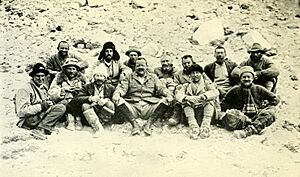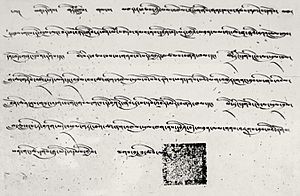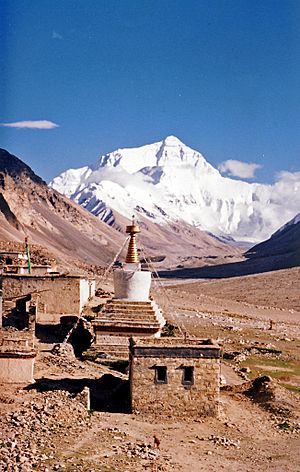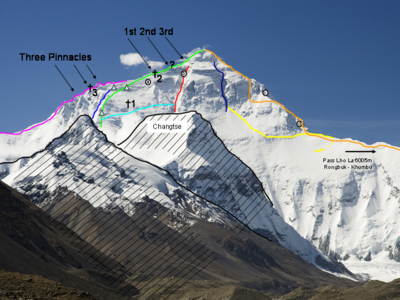1922 British Mount Everest expedition facts for kids
The 1922 British Mount Everest expedition was the first time climbers tried to reach the very top of Mount Everest. It was also the first expedition to use special bottled oxygen to help climbers breathe high up. The team tried to climb Everest from the north side, starting in Tibet. At that time, climbers could not go from the south side because Nepal was closed to visitors from Western countries.
The 1921 British Mount Everest reconnaissance expedition had already explored the areas around the mountain. During that trip, George Mallory found a possible path to the summit. Mallory was also part of the 1922 and 1924 expeditions.
After two tries that did not reach the top, the expedition ended sadly. Seven Nepalese porters died in an avalanche. This was the first time people died while climbing Everest. Even though they did not reach the summit, the expedition set a new world record. They climbed to 8,321 metres (27,300 ft), which was the highest anyone had ever climbed. This record was broken later in the 1924 expedition.
Contents
Getting Ready for the Climb
The British wanted to be the first to "conquer" Mount Everest. They had not been the first to reach the North Pole or South Pole. So, they aimed for the "third pole," which was Everest.
Plans for climbing Everest started even before 1922. The Royal Geographical Society and the Alpine Club worked together. They formed the Mount Everest Committee to organize these big trips.
Maps made during the 1921 expedition were very important for the 1922 climb. John Noel was the official photographer. He brought many cameras, including small ones that climbers could carry high up. These small cameras were meant to take pictures if they reached the summit. Thanks to Noel, we have many photos and a movie from the expedition.
The 1921 team learned that the best time to climb was in April or May. This was before the heavy monsoon rains. The 1922 and 1924 expeditions used this knowledge.
Using Oxygen to Climb
The 1922 expedition was the first to use bottled oxygen on Everest. This started a long discussion about whether using oxygen was "fair" in the "death zone" (very high altitudes).
A scientist named Alexander Mitchell Kellas thought oxygen could help climbers. But the oxygen systems available then were too heavy. Kellas was on the 1921 expedition but sadly died on the way to Everest. The 1921 team had oxygen bottles, but they did not use them.
Professor Georges Dreyer also studied how people could survive at high altitudes. He worked with George Ingle Finch. Their experiments showed that extra oxygen was needed to survive very high up.
Because of this research, the 1922 expedition decided to use bottled oxygen. Each bottle held about 240 liters of oxygen. Four bottles were put on a frame, making a total weight of 14.5 kg (about 32 pounds). Climbers had to carry this heavy load. Ten of these systems were brought along. Climbers wore a mask over their mouth and nose.
Dreyer suggested how much oxygen to use. At 7,000 m (22,970 ft), they would use 2 liters per minute. For the summit climb, they would use 2.4 liters per minute. This meant each bottle would last about two hours. So, all the oxygen would be used up after a maximum of 8 hours of climbing. Today, modern oxygen bottles are much lighter and last longer.
George Finch was in charge of the oxygen equipment. He was a chemist and understood the technology. He made his fellow climbers practice using the equipment every day. However, the oxygen systems often broke, were not strong, and were very heavy. Many climbers did not like them and wanted to climb without them. The local porters called the oxygen bottles "English air."
Expedition Team Members
The people chosen for the expedition were picked for their climbing skills. But their family background, military experience, and jobs were also important.
| Name | Role | Job |
|---|---|---|
| Charles G. Bruce | Leader | Soldier (Brigadier) |
| Edward Lisle Strutt | Assistant Leader and Climber | Soldier (Lieutenant-Colonel) |
| George Mallory | Climber | Teacher |
| George Ingle Finch | Climber | Chemist |
| Edward "Teddy" F. Norton | Climber | Soldier (Major) |
| Henry T. Morshead | Climber | Soldier (Major) |
| Dr Howard Somervell | Climber | Doctor |
| Dr Arthur Wakefield | Climber | Doctor |
| John Noel | Photographer and Filmmaker | Soldier (Captain) |
| Dr Tom G. Longstaff | Expedition Doctor | Doctor |
| Geoffrey Bruce (Charles G. Bruce's cousin) | Translator and Organizer | Soldier (Captain) |
| C. John Morris | Translator and Organizer | Soldier (Captain) |
| Colin Grant Crawford | Translator and Organizer | British government officer |
A large group of Tibetan and Nepalese porters joined the climbers. In total, the expedition had 160 men.
Journey to Mount Everest
The journey to the base camp mostly followed the same path as in 1921. The expedition members met in Darjeeling, India, in late March 1922. Some had arrived earlier to hire porters. Most of the team started their journey on March 26. Crawford and Finch stayed a few extra days to arrange transport for the oxygen systems. These systems arrived late in Kolkata. But the rest of the journey with the oxygen bottles went smoothly.
The team had permission from the Dalai Lama to travel through Tibet. From Darjeeling, they went to Kalimpong. There, they visited St Andrew's Colonial Home and rested for a few days. Then they traveled to Phari Dzong and Kampa Dzong, arriving on April 11. They rested for three days so Finch and Crawford could catch up with the oxygen bottles.
Next, they went to Shelkar Dzong, then north to the Rongbuk Monastery. Finally, they reached the spot for base camp. To help them get used to the high altitude, they walked and rode horses. On May 1, they reached the lower part of the Rongbuk Glacier, where they set up base camp.
Climbing Path
Before World War II, Everest could only be climbed from the north side in Tibet. Nepal was closed to foreign climbers. In 1921, Mallory found a possible route from the Lhakpa La to the north face of the mountain.
This route starts at the Rongbuk Glacier. It goes through the valley of the eastern Rongbuk Glacier. Then it leads to the icy eastern slopes of the North Col. From there, climbers go along the North Ridge and Northeast Ridge towards the summit.
A very difficult part of this route is the Second Step at 8,605 m (28,230 ft). This step is about 30 m (98 feet) high, with a very steep slope. The last part is almost a straight up wall, about seven meters high. After this, the path leads to the summit with long, gentle slopes. The first successful climb on this route was by a Chinese team in 1960.
The British also considered another route. This path would go up the north wall of the mountain. It would use a steep gully, later called the Norton Couloir, to reach the Third Step and then the summit. Reinhold Messner used this route for his first solo climb in 1980.
Attempts to Reach the Summit
The base camp area was known from the 1921 trip. But no one had explored the eastern Rongbuk Glacier valley yet. So, on May 5, Strutt, Longstaff, Morshead, and Norton explored this valley.
They set up an Advanced Base Camp (ABC) at the top of the glacier, below the icy slopes of the North Col. This camp was at 6,400 m (21,000 ft). Between the base camp and ABC, they set up two more camps: Camp I at 5,400 m (17,720 ft) and Camp II at 6,000 m (19,690 ft). Local farmers helped set up and supply these camps. Longstaff became very tired from organizing and carrying supplies. He got so sick that he could not do much climbing later.
On May 10, Mallory and Somervell left base camp to set up Camp IV on the North Col. They reached Camp II very quickly. On May 11, they started climbing the North Col. This camp was at 7000 m (22,966 feet) and had food supplies. The plan was for Mallory and Somervell to try climbing without oxygen first. Then, Finch and Norton would try with oxygen. However, many climbers got sick. So, the healthy climbers—Mallory, Somervell, Norton, and Morshead—decided to climb together.
First Try: Without Oxygen
Mallory, Somervell, Norton, and Morshead made the first attempt without oxygen. Nine porters helped them. They started from Camp III on May 19. They climbed to the North Col by 8:45 a.m. The day was sunny. Around 1 p.m., they set up their tents.
The next day, May 20, Mallory woke up early. The porters had not slept well because their tents did not have enough air. Only five porters felt well enough to go higher. They started climbing around 7 a.m., but the weather got worse and it became very cold. Above the North Col, they were climbing in an unknown area. No one had ever climbed so high on Everest before. The porters were shivering because they did not have warm clothes.
It was too hard to cut steps into the icy slopes. So, they changed their plan to set up a camp at 7,925 m (26,000 ft). Instead, they went to 7,620 m (25,000 ft) and set up a small camp called Camp V. Somervell and Morshead set up their tent straight. But Mallory and Norton had to use an uncomfortable sloped spot about 50 meters away. The porters were sent back down the mountain.
On May 21, the four climbers woke up around 6:30 a.m. and were ready by 8 a.m. While getting ready, a backpack with food fell down the mountain. Morshead, who was already fighting the cold, got the backpack back. But he was too tired to climb higher.
Mallory, Somervell, and Norton continued climbing along the north ridge. It started to snow lightly. Mallory said the snow ramps were not hard to climb. Shortly after 2 p.m., they decided to turn back. They were 150 m (492 feet) below the ridge. They had reached 8,225 m (26,985 ft), which was a new world record for climbing height. Around 4 p.m., they got back to Morshead at the last camp and climbed down with him.
They almost had an accident when all the climbers except Mallory started to slip. But Mallory held them with his rope and ice axe. They got back to Camp V in the dark. On May 22, 1922, they started climbing down from North Col at 6 a.m.
Second Try: With Oxygen
| green line | Normal route, mainly the route tried in 1922. High camps around 7700 and 8300 m. |
| red line | Great Couloir or Norton Couloir |
| dark blue line | Hornbein Couloir |
| ? | 2nd step at 8605m, about 30m high, very difficult. |
| a) | Spot at about 8325m where George Finch climbed with bottled oxygen. |
The second climb was made by George Ingle Finch, Geoffrey Bruce, and a Gurkha officer named Tejbir. They used oxygen. After Finch felt better, he looked for other climbers who were fit enough. Bruce and Tejbir seemed ready. In the days before, oxygen bottles had been moved to Camp III.
On May 20, the three climbers went to Camp III. They checked the oxygen bottles and found them in good condition. On May 24, they climbed to the North Col with Noel. The next day, May 25, Finch, Bruce, and Tejbir started climbing at 8 a.m. They went along the north ridge and then to the northeast ridge. A very strong wind made climbing difficult. Twelve porters carried the oxygen bottles and other gear.
It became clear that using oxygen was a great help. The three climbers could move much faster than the porters, even with their heavy loads. As the wind got stronger, they set up camp at 7,460 m (24,480 ft). The next day, May 26, the weather got worse, and they could not climb further.
They tried again on May 27. By this point, they were almost out of food because the climb had lasted longer than planned. Still, they started at 6:30 a.m. The sun was shining, but the wind kept getting stronger. Tejbir did not have suitable clothes for the wind. He got slower and slower and collapsed at 7,925 m (26,000 ft). Finch and Bruce sent him back to camp.
Finch and Bruce continued to the northeast ridge, but they were no longer tied together with a rope. At 7,950 m (26,080 ft), Finch changed their route because of the strong wind. They went into the north wall, towards the steep gully later called "Norton Couloir." They moved well sideways but did not gain much height. At 8326 m (27,316 feet), Bruce had a problem with his oxygen system. Finch realized Bruce was exhausted, so they turned back. During this climb, they broke the height record again. At 4 p.m., they got back to the camp on the North Col. An hour and a half later, they were back at Camp III.
Third Try: Avalanche Tragedy
Dr. Longstaff thought they should not try a third time because all the climbers were tired or sick. But Somervell and Wakefield did not see big risks, so a third attempt was made.
On June 3, Mallory, Somervell, Finch, Wakefield, and Crawford started from base camp with 14 porters. Finch had to stop at Camp I. The others reached Camp III on June 5 and stayed there for a day. Mallory was impressed by Finch's strength in the second attempt. Mallory now also wanted to use oxygen.
On June 7, Mallory, Somervell, and Crawford led the porters through the icy slopes of the North Col. The 17 men were divided into four groups, each tied together with ropes. The European climbers were in the first group, making a path in the snow. Halfway up, a piece of snow broke loose. Mallory, Somervell, and Crawford were partly buried but managed to free themselves.
The group behind them was hit by a huge avalanche of 30 m (98 feet) of heavy snow. Nine porters in two groups fell into a deep crack in the ice (crevasse) and were buried under massive amounts of snow. Two porters were dug out alive. Six other porters had died. One porter could not be found, dead or alive. This terrible accident ended the climbing attempts and the expedition.
Mallory had made a mistake by trying to go straight up the icy slopes instead of taking a safer path in curves. This caused the avalanche.
On August 2, all the European expedition members were back in Darjeeling.
After the Expedition
After returning to England, Mallory and Finch traveled around the country. They gave talks about the expedition. This tour had two goals: to share information about the expedition and to raise money for another trip. Mallory also went on a three-month trip to the United States. During this trip, someone asked Mallory why he wanted to climb Mount Everest. His famous answer was: "Because it is there."
The planned 1923 expedition to Mount Everest was delayed. There was not enough time or money to prepare another trip for the next year.
The movie that Noel filmed during the expedition was also shown to the public. Climbing Mount Everest played for ten weeks in Liverpool's Philharmonic Hall.
The European expedition members received an Olympic medal for alpinism (mountain climbing) at the 1924 Summer Olympic Games. Pierre de Coubertin, who started the modern Olympics, gave each of the 13 participants a silver medal with gold on top.
See also
- Timeline of Mount Everest expeditions








